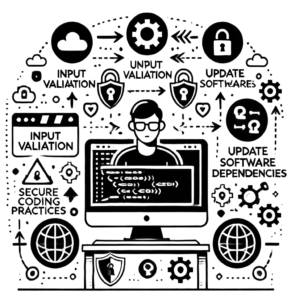The Importance of Secure Coding
In today’s world of technology, it’s important for developers to use secure coding practices to protect their work from cyber threats. These threats are always changing and can include things like viruses, scams, and other malicious attacks. By staying informed about these risks, developers can create stronger, more secure code that is less likely to be hacked.
One important way to protect against potential security threats is to always check and verify the data that comes into a program. This is called input validation. Making sure that only safe and approved data gets processed helps prevent harmful attacks like injections. By carefully checking data before accepting it, developers can reduce the chances of security issues.
Additionally, keeping software dependencies up to date is crucial in safeguarding code against potential threats. Outdated dependencies may contain known vulnerabilities that can be exploited by attackers. By regularly updating dependencies and incorporating security patches, developers can effectively fortify their code against emerging threats in the ever-evolving threat landscape.
Overview of Secure Coding
In the world of cybersecurity, following secure coding practices is important for keeping software safe from hackers and cyber attacks. Using strong coding techniques helps ensure that the code is trustworthy and kept private. By using the best secure coding practices, developers can reduce the chances of security issues and keep their apps safe from harmful attacks.
One of the primary aspects of secure coding is input validation, where developers sanitize and validate user input to prevent injection attacks such as SQL injection or cross-site scripting. By carefully validating all input data, developers can reduce the chances of attackers exploiting vulnerabilities in the application.
Additionally, proper error handling is another critical component of secure coding. By implementing effective error handling mechanisms, developers can prevent sensitive information leakage and provide users with secure and reliable software experiences. Thoroughly testing the codebase for vulnerabilities and regularly updating dependencies are also essential practices to maintain the security of the software.
In simple terms, it’s really important for developers to use secure coding practices when building apps. This helps make sure the apps can stay safe and strong even as cyber threats keep changing. By focusing on security from the start of building an app, companies can make sure their code stays safe and strong against growing cybersecurity risks.
Common Vulnerabilities and How to Avoid Them
Injection Attacks

Injection attacks are a common type of cybersecurity threat that developers need to be aware of in order to protect their code from vulnerabilities. These attacks occur when an attacker is able to inject malicious code into a software application, often by exploiting vulnerabilities in input validation mechanisms.
Preventing injection attacks requires implementing secure coding practices such as input validation, parameterized queries, and stored procedures. By validating user inputs and using parameterized queries, developers can significantly reduce the risk of injection attacks. Additionally, limiting the permissions of database users and avoiding dynamic SQL queries can also help mitigate the risk of injection vulnerabilities.
It’s important to keep your computer’s security up to date and to use tools like web application firewalls to protect against attacks. By staying informed about online threats and writing secure code, developers can keep their programs safe and protect important information from hackers.
Buffer Overflows
Buffer overflows are often found in software applications and can be used by hackers to break into a system without permission. This happens when a program tries to store more information than it can handle in a certain place in the computer’s memory. Hackers can use this to mess with important data, run harmful code, or make the program stop working correctly.
To protect your code from buffer overflows, it is essential to follow secure coding practices. One of the key strategies is input validation, ensuring that all user inputs are properly validated and sanitized before being processed by the program. Additionally, developers should use safe functions that limit the length of input data and prevent buffer overflows.
Another important practice is implementing bounds checking to ensure that data is written to memory locations within the allocated buffer size. Using memory-safe languages like Rust or leveraging tools like AddressSanitizer can also help in detecting and preventing buffer overflow vulnerabilities in your code.
By following these safe coding techniques, you can greatly lower the risk of attackers exploiting your software through buffer overflow and make sure your applications are more secure overall.
Insecure Direct Object References
One important way to keep your code secure from hackers is to be aware of Insecure Direct Object References (IDOR). This means that certain parts of your application, like user profiles or sensitive information, can be accessed by unauthorized users if they know where to look in the URL or hidden fields. To protect your code from IDOR attacks, developers should always make sure that user requests are properly checked and verified before giving access to any resources. Using tools like role-based access control can help lessen the chances of IDOR causing problems for your application.
By prioritizing the prevention of Insecure Direct Object References in your coding practices, you can enhance the overall security of your application and safeguard sensitive data from unauthorized access. Regular code reviews, security testing, and monitoring for IDOR vulnerabilities are essential steps to maintain a robust defense against potential security threats.
Top Secure Coding Practices
Input Validation
One of the fundamental aspects of secure coding is input validation. Input validation is crucial for protecting your code from various vulnerabilities such as injection attacks, cross-site scripting (XSS), and buffer overflows. By validating all user inputs, developers can ensure that the data being processed meets the expected format and criteria, thus preventing malicious input from causing harm.
Implementing proper input validation involves thoroughly checking and sanitizing all user-provided data before processing it within the application. This includes validating data types, length restrictions, and acceptable characters. By enforcing strict validation rules, developers can reduce the risk of code injection and other common attacks that exploit inadequate input validation.
Furthermore, using input validation tools can make the application more secure and better able to defend against cyber attacks. When developers ensure that input is being checked properly, it helps to strengthen the security of the code and protect against potential weaknesses.
Security By Obscurity: Top Secure Coding Practices
When it comes to safeguarding your code from vulnerabilities, adopting a proactive approach is key. One common yet debated practice in the realm of cybersecurity is the concept of “security by obscurity.” This approach involves implementing security measures that rely on keeping certain aspects of the system hidden or not widely known to potential attackers. While security by obscurity should never be the sole line of defense, when combined with other robust security practices, it can add an extra layer of protection to your codebase.
It’s important to know that just trying to hide flaws in your code isn’t enough to keep it secure. To really protect your work, developers should use security methods like strong passwords, checking input for errors, handling mistakes properly, and regularly checking their code for issues. By combining these good practices with keeping some details of their code secret, developers can greatly lower the chance of their work being used for harm by hackers.
In conclusion, while security by obscurity should not be the primary defense mechanism, it can complement other secure coding practices effectively. By implementing a holistic approach to cybersecurity that includes both proven security measures and elements of obscurity, developers can create resilient code that stands strong against potential threats.
Least Privilege Principle
Following the Least Privilege Principle is very important in cybersecurity and coding securely. This principle suggests giving users, applications, or processes just enough access or permissions to do their job, which helps prevent a lot of damage if there’s a security issue. By sticking to this principle, developers can make it harder for hackers to get into their systems and lower the chances of someone gaining unauthorized access or more permissions than they should have.
Adhering to the Least Privilege Principle can make an application or system more secure. It means each part only has the minimum amount of access it needs, which can lessen the damage if there’s a breach. By carefully managing who has access to what, developers can stop hackers from misusing extra permissions to get into important information or system parts.
Incorporating the Least Privilege Principle into the development process not only reinforces security measures but also fosters a proactive security mindset among developers. It encourages the evaluation of access controls and permissions at every stage of development, from design to deployment, promoting a security-first approach that prioritizes safeguarding against vulnerabilities and potential exploits.
Implementing a Secure Coding Lifecycle
Training and Awareness
Protecting your code from hackers involves training and raising awareness. When your team understands how to write secure code, it becomes more difficult for cyber attackers to find and exploit vulnerabilities. Training sessions should include topics such as verifying incoming information, implementing secure login methods, and ensuring data is transmitted safely. With these skills, your developers can create secure code from the start.
It’s important to educate your team about secure coding practices to create a culture of security in your organization. Encouraging developers to stay informed about the latest security issues can help them anticipate threats and protect your applications from cyber attacks. By investing in training and awareness efforts, you can help your team write code that is secure and keep your systems safe from breaches.
Testing and Code Review
Checking and reviewing your code are important steps in making sure it’s safe from hackers. When you thoroughly test and review your code regularly, you can find and fix any weaknesses before they can be used against you.
Testing involves systematically evaluating the functionality and security of your code through various methods such as unit testing, integration testing, and penetration testing. These tests help ensure that your code behaves as expected and is resilient to common security threats.
Code reviews, on the other hand, involve having your code examined by peers or security experts to provide feedback on potential issues such as insecure coding practices, inadequate error handling, or vulnerabilities in third-party dependencies. This collaborative approach can help improve the overall quality and security of your codebase.
By prioritizing testing and code review as part of your secure coding practices, you can fortify your applications against potential cyber threats and build a more secure digital environment for your users.
Continuous Improvement
In order to keep your code safe from hackers, it’s important to constantly work on improving your coding practices. This includes regularly updating and fixing any issues in your code to protect it from new threats. Having other people review your code and doing security checks can help catch problems early on. By staying up to date on the latest security tips, developers can make their code more secure against attacks. Remember, keeping your code safe is an ongoing task that requires attention and dedication to prevent any harmful attacks.
Importance of Keeping Up-to-Date
Staying informed about the latest secure coding practices is crucial in protecting your code from vulnerabilities. Regularly updating your knowledge base helps you stay ahead of cyber threats and potential exploits. By keeping up-to-date with emerging security trends and best practices, you can proactively implement measures to safeguard your code from malicious attacks. Ignoring the importance of staying current with secure coding techniques can leave your software exposed to vulnerabilities that could be exploited by hackers. Make it a priority to stay informed and continuously enhance your coding practices to ensure the security of your applications.
Secure Coding as a Defensive Strategy
Staying informed about the latest secure coding practices is crucial in protecting your code from vulnerabilities. Regularly updating your knowledge base helps you stay ahead of cyber threats and potential exploits. By keeping up-to-date with emerging security trends and best practices, you can proactively implement measures to safeguard your code from malicious attacks. Ignoring the importance of staying current with secure coding techniques can leave your software exposed to vulnerabilities that could be exploited by hackers. Make it a priority to stay informed and continuously enhance your coding practices to ensure the security of your applications.
